Mangoes are one of the many blessings summers bring for us, and there is a reason why they are called the “king of fruits.” Thanks to them being rich, sweet, luscious, juicy, and delicious, they are widely cultivated in tropical and sub-tropical climates.The best time to plant a mango is in the summer when it is warm and humid. In weather like this, baby mangoes get the kickstart they need to give you fruits all their lives. Unfortunately, many of us don’t have gardens or land to grow mangoes. But don’t fret, mangoes are not exactly difficult to grow, and they do well indoors. Of course, until they are trees, then you will have to plant them outdoors. This article is all about helping you plant mango trees indoors. Here we will talk about how to grow a mango tree indoors. (#Ads)
Without further ado, let’s start.
How to grow a Mango tree indoors
Mango Tree Germination and Planting in Pot
To speed up the planting process, it’s better to germinate the seed before planting it. The best part is, unlike most fruit trees, mango trees grow easily from seed. All you need is a fresh mango pit, and you can easily germinate and plant your mango tree. Lets check the step by step process .
Step 1: Scrape all the excess fruit

Scrape all the excess fruit of the mango pit. This step is especially important to ensure you complete the next step properly. Removing the excess fruit is fairly easy. It’s better that instead of washing the pit, you scrape the fruit using a butter knife.
Step 2 : Remove the hard husk from the seed
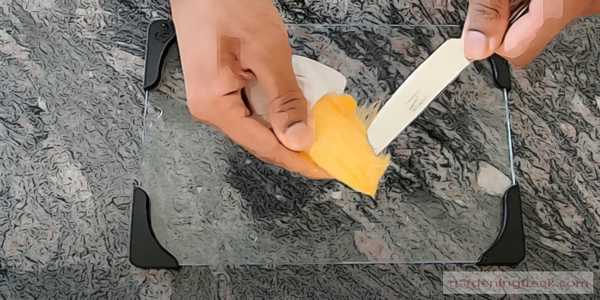
The next step is to remove the hard husk from the seed. Of course, you can plant the pit with it, but it will take much longer to germinate. Once the excess fruit is off, feel around the pit for a bump. Wrap a paper towel on that area and carefully slip the husk on the opposite side of the bump. Do this task using a butter knife to ensure you don’t damage the seed inside. Wiggling the knife, a little bit will cut the husk open.
Step 3 :Dampen a paper towel with water

Once you have the seed, get a piece of paper towel and dampen it with water. It’s easy if you are using a spray bottle. Make sure it’s properly soaked in water. If you feel the towel is not damp enough spray more water after wrapping it.
Step 4: Wrap the seed with the wet paper towel and put it inside a plastic bag
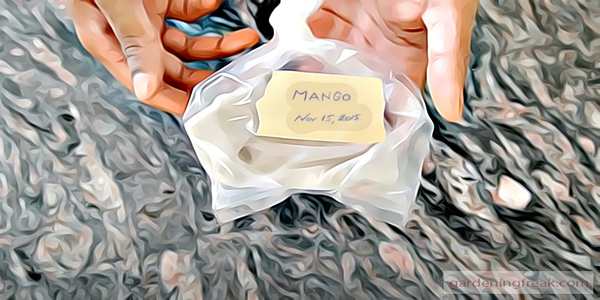
Wrap this paper towel around the seed. Put the wrapped seed in a plastic bag. For your ease, it’s important that you label it will the name of the fruit and the date of wrapping. Leave it like this for two weeks.
Step 5 : Plant the newly developed plant in a pot
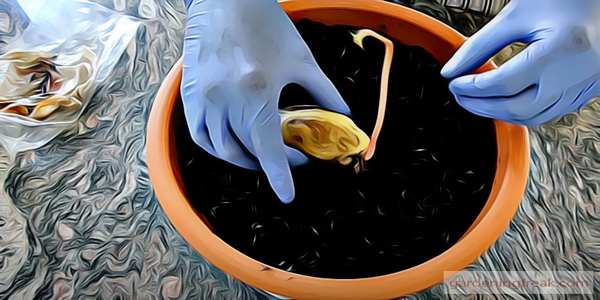
As soon as you see the roots developing at the bottom, plant it in the pot. Make sure the shoot stands straight.
Growing Mango Tree in Pot
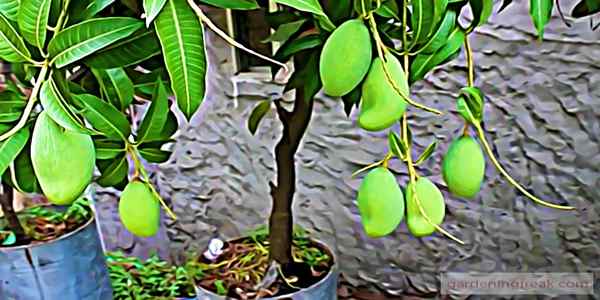
Planting a mango tree in a pot is considerably easy.
Growing methods
There are two main methods to do this:
- By grafting,which means inserting a shoot or twig of mango tree into the soil. Or you can cut the mature branch of mango trees by using grafting tools and attach it with other mango tree’s branches. By doing so, you can enjoy different kinds of mango from a single mango trees .
- By planting the germinated seed.
Types of soil
In either method, soil composition is extremely important. It not only ensures the health of your plant but also increases the growth rate. Usually, for planting mango trees, soil consisting of 70 percent garden soil, 20 percent vermicompost, and 10 percent sandis used. However, you can change the ratios slightly and add a little peat moss if you want to. Make sure all the contents are thoroughly mixed. Since fruit tree roots are more vulnerable to fungal attacks, it is advised that you add some fungicide powder into the mixture as well.
Mango tree Pot types
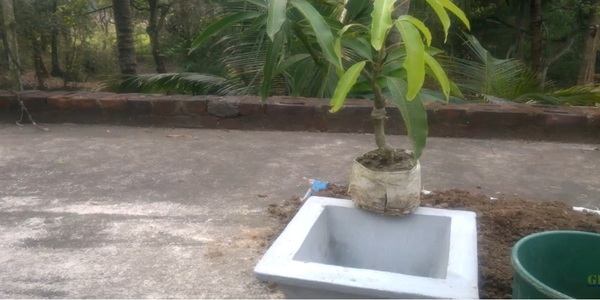
Mango trees usually grow up to be very big, which is why their roots grow relatively fast. Hence, make sure you use a pot that is 12 inches or larger. Also, it is imperative that the pot has a proper drainage system. Once the pot is ready, plant your germinated seed in the pot. Make sure the shoot stands straight, and the seed part is immersed in soil.
Mango Tree Growth Rate in Indoor VS Outdoor Pot and Container
Mango trees are native to the tropical areas. Hence, they require warm conditions and blooming sun to grow properly. Usually, a mango tree can grow from 30 feet to 100 feet in height and have a bushy shrub-like appearance. In most cases, the growth rate of a mango tree indoor is pretty slow as compared to its growth rate outdoors. Since the plant needs an ample amount of direct sunlight, providing such conditions indoors is usually difficult, which is why indoor mango trees do not bear fruit in some cases.
An average mango plant starts producing fruit in six to seven years after planting. If you want to plant a mango tree in a colder region, then protecting the plant from cold and frost is extremely important. Hence, you might have to shuffle the tree indoors and outdoors during seasons. No authentic studies are comparing the growth rate of indoor mango plants and outdoor mango plants. However, according to well-known gardeners, mango trees planted indoors grow at a much slower pace. But if you can manage proper soil mixture, fertilizer and sunlight for your potted mango plant you can get good result and also get some mango also.
How to Grow Mango Tree Faster on Indoor
Although there is no shortcut to growing your mango plant as fast as it will grow outdoors, here are a few things that you can do to ensure faster growth and that will also help to get you some delicious mango.
Ample sunlight
Place your plant in an area where it gets proper sunlight for at least six to eight hours every day. Mostly window sills and sunroofs work well for indoor mango trees.
Soil composition
Soil composition plays a very important role in how healthily your plant grows. Hence make sure your plant gets the proper soil conditions.
Watering
Since your mango plant is indoor, the plant does not require as much water as an outdoor plant does. So, make sure you do not overwater the plant.
How Much Water Does A Mango Tree Need When It Is in Indoor
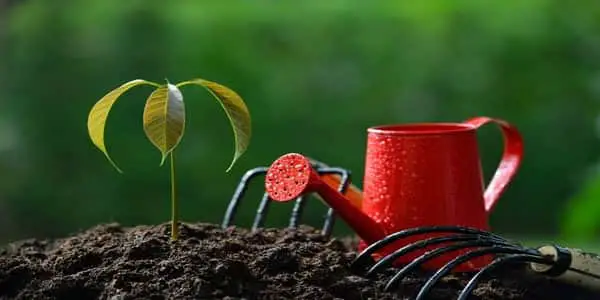
Watering is very crucial for a mango tree, especially in the first two years of its lifetime. Outdoor mango trees receive ample water in the monsoon season. However, since you will be keeping your mango tree indoor, you have to be extra careful regarding the watering of the plant. In warmer months, the mango tree needs to be watered three to four times a week. If you have a proper drainage system in your pot, you don’t have to worry about overwatering the plant. Don’t let the top part of the soil become dry. In winter months, on the other hand, watering your plant once a week is enough in most cases. The thumb rule, i.e., doesn’t let the top layer of the soil become dry, remains the same.
Indoor Mango tree care
Caring for an indoor mango tree is definitely trickier than caring for an outdoor mango tree. Outdoor plants not only receive fertilizers in the form of foliage, but they also receive water in the form of rain. Indoor plants, however, are completely dependent on you for all nutrition.
Use Balance fertilizer
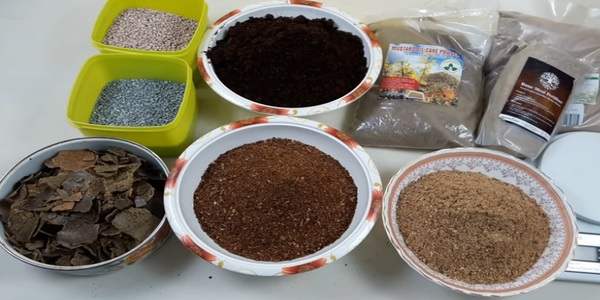
Hence, other than properly watering the plants based on the weather, you have to add a balanced, properly created, soluble houseplant fertilizer in the summer months. Meanwhile, in winters, you should not only reduce the frequency of adding water but also withhold adding fertilizers.
Pruning new leaves and snipping off first-year flower
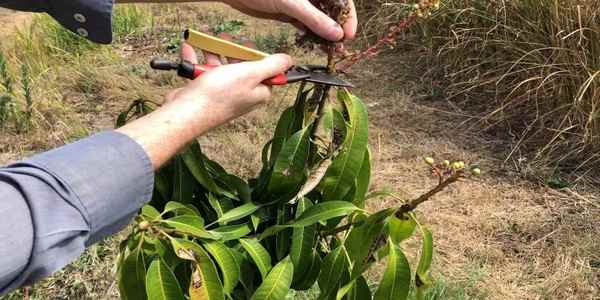
Pinching the top leaves from the top occasionally and snipping off the first year’s flowers will ensure proper plant growth. These two things is very crucial at the fart 2 years of the plant which also ensure the plant health and healthy growth.
Place the plant in a sunny place
Also, make sure the plant is placed in a window sill or under a sunroof where it gets plenty of sunlight.
FAQs
Some of the frequently asked questions that can help in clearing your concepts regarding growing mango plants indoor are
Does the water temperature matter for mango trees?
Where studies don't show any evidence that water temperature matters, gardeners believe that adding lukewarm water to the plant ensures proper absorption of water, hot or cold water reduces water absorption by the roots.
Can you directly plant the mango seed with hard husk?
Yes, the seed is meant to be planted with the hard husk naturally. However, it will take a month more to germinate. If you don't mind that, you can plant it with the husk.
Does this method work for other seeds?
Yes, the paper towel germination method works for most seeds, including peach and nectarine seeds. However, every seed plantation has its own technicalities. Make sure you have them in mind before going forward with the germination.
Do indoor lights work as sunlight for mango trees?
Although there are many full-spectrum light options that you can invest in for indoor plants. Its always better to keep a mango plant in direct sunlight.
Conclusion
Mango trees are one of the most rewarding trees when it comes to fruit trees. Even though they require a little care initially and the plantation process is slightly tedious. After two years of age, the trees are pretty much self-sufficient. They can easily survive on rainwater and do not require a lot of fertilization either. However, grown mango trees need to be planted outdoors.
You can use mango trees as indoor plants for the first year or two; after that, due to their growing size and needs, it’s important to shift it outdoors. However, if you want to grow your mango trees in indoor make sure you add fertilizer after every two or three years and get them lot of sunlight. If you can do so, you can enjoy some sweet mango even in from your indoor garden. Hope after going through this article you get some basic idea about how to grow a mango tree indoors.
















